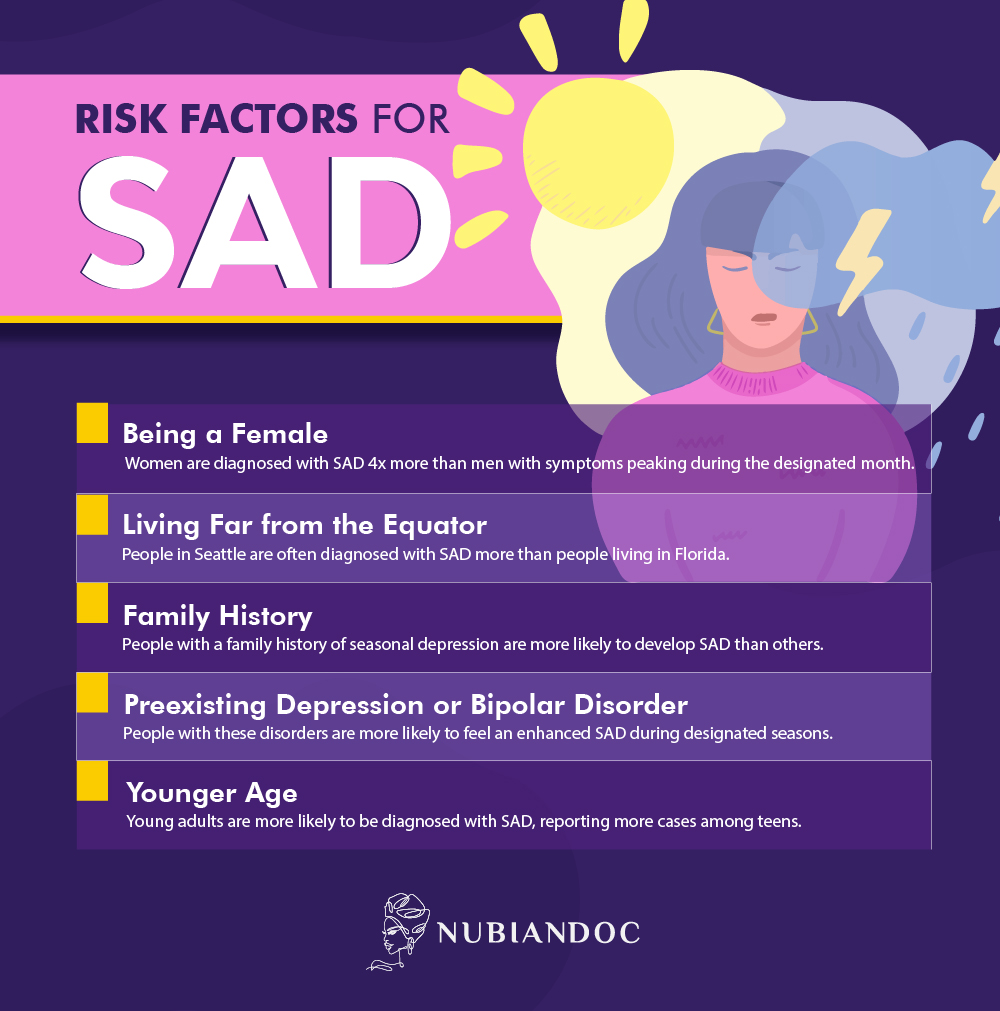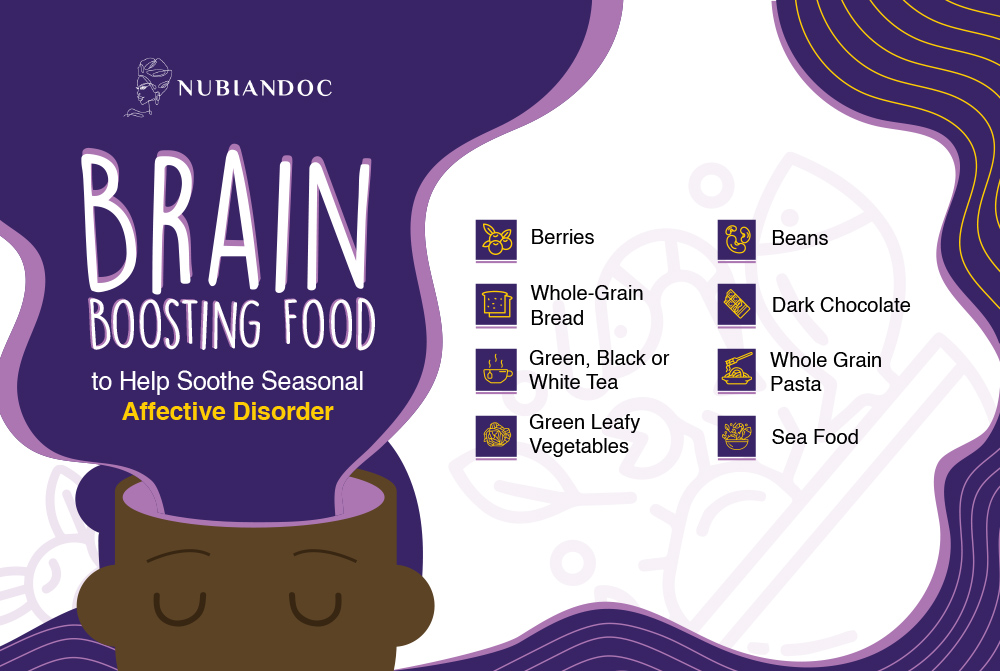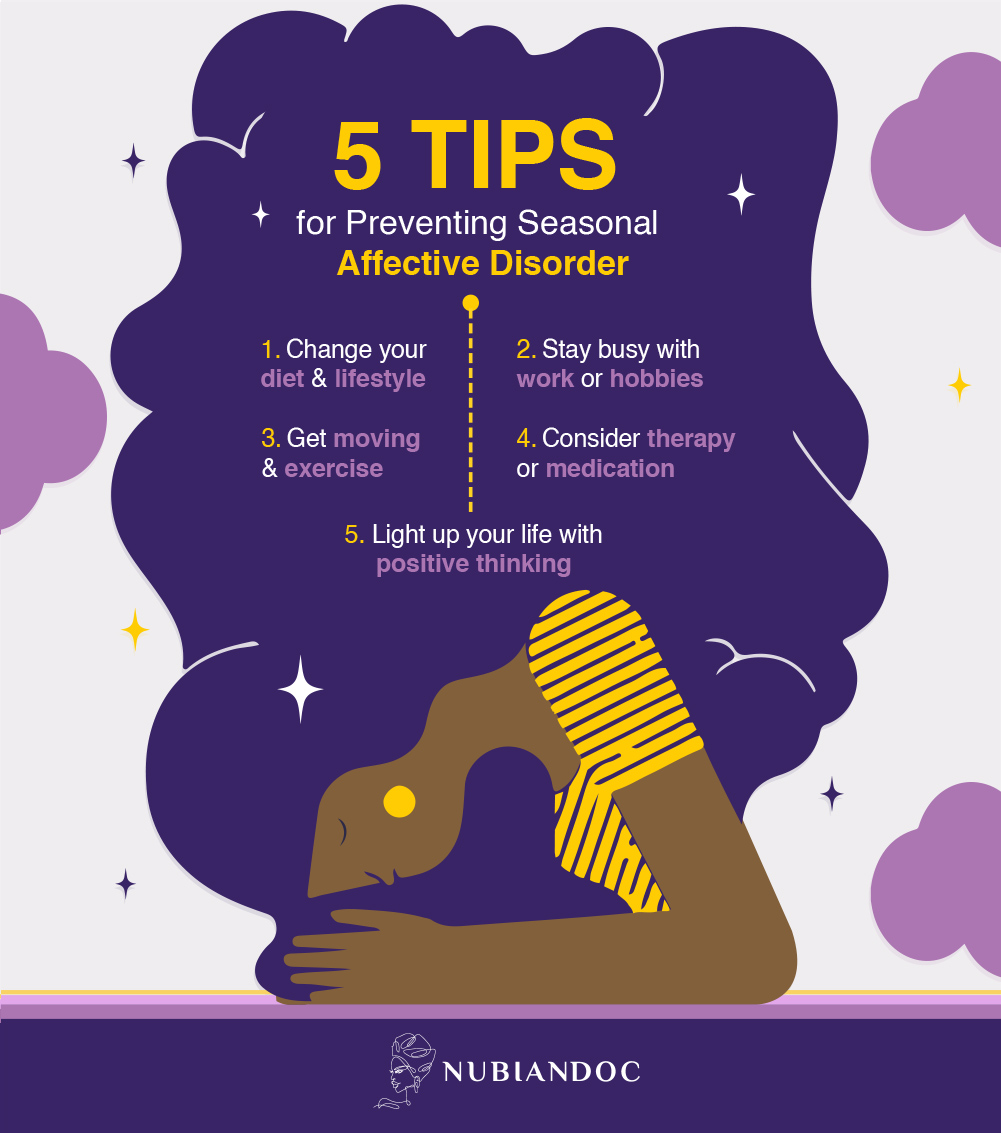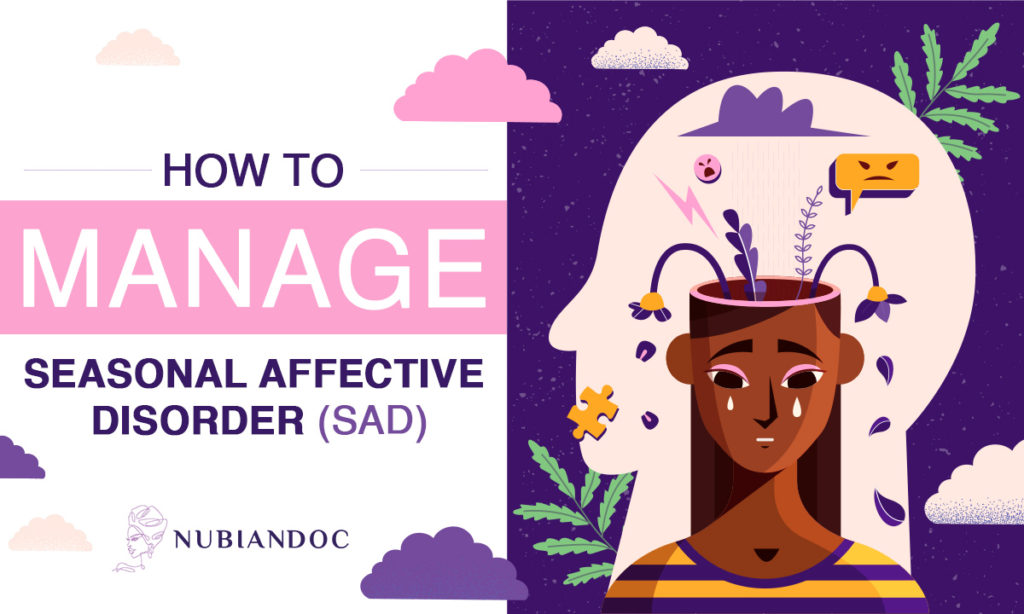SAD | History | Symptoms | Diagnosis | Causes | Risk Factors | Ways to Manage | Role of Nutrition | Brain Boosting Food | Recipes to Try | Self-Care Tips | Bottom Line
Though the fall/winter season can be a time for celebration for many people around the globe, it can bring on significant mood symptoms for some. Seasonal Affective Disorder (SAD), a variant of depression that develops during particular seasons, makes some people experience winter blues (consisting of gloominess and sluggish behavior) for a certain period of time.
The following article provides in-depth detail about SAD, and a variety of techniques to manage this disorder.
What is Seasonal Affective Disorder?
Seasonal Affective Disorder (SAD) is a ‘seasonal depression’ that affects people more specifically during the fall and winter months. It thus has a periodic pattern and abates during other parts of the year. Others may experience the opposite with summer depression, but this is rare.
SAD can occur in both genders, but is more prevalent among women. Holding a greater impact on people who live far from the equator (where daylight hours are shorter), SAD affects people mostly from the age groups of 15 to 55 and is uncommon among the elderly. In layman’s terms, it is referred to as winter depression, summertime sadness or, as mentioned, seasonal depression.
Summary: Seasonal Affective Disorder (SAD) or ‘seasonal depression’ is a ‘mood disorder’ that affects people globally every year, specifically during the fall and winter seasons.
What is the History of Seasonal Affective Disorder?
In 1984, the term ‘Seasonal Affective Disorder’ was first used in a paper by Norman Rosenthal and his colleagues at the National Institute of Mental Health in Bethesda, MD.
After thirty years of continuous investigations by scientists, representatives from SADA, biologists and professors all acknowledged that the disorder was occurring in a significant proportion of the world’s population.
To address the theories of causation, various discussions took place (on both medical and natural treatment of the disorder) regarding a potential overproduction of melatonin, decrease in serotonin levels, and a subsequent impact on circadian rhythms associated with the disorder. Also a link between SAD and limited vitamin D production from less outdoor sun expose has also been suggested.
Perceptions related to SAD (as well as diagnostic classifications) were also a part of these findings.
Summary: In 1984, the term ‘Seasonal Affective Disorder’ came into light when it was first used in a paper by Norman Rosenthal and his colleagues at the National Institute of Mental Health in Bethesda, MD.
Signs and Symptoms of Seasonal Affective Disorder
SAD symptoms are similar to depression symptoms. Winter-pattern SAD symptoms, however, are different from summer-pattern SAD symptoms and may vary from person to person.
Major symptoms of Depression may include:
- Feeling a loss of motivation
- Losing interest in activities once enjoyed
- Experiencing changes in appetite
- Changes in weight (involving loss or gain)
- Feeling agitated, irritated, annoyed or sluggish
- Having low energy throughout the day
- Having difficulty concentrating or focusing
- Having thoughts of suicide
Winter-pattern SAD symptoms may include:
- Oversleeping (hypersomnia)
- Overeating, particularly with a craving for carbohydrates
- Weight gain
- Social withdrawal (feeling like ‘hibernating’)
Summer-pattern SAD symptoms may include:
- Trouble sleeping (insomnia)
- Poor appetite, leading to weight loss
- Restlessness and agitation
- Anxiety
- Episodes of violent behavior
- Decreased appetite
Estimated prevalence of Seasonal Affective Disorder symptoms (for patients with different diagnoses):
| Estimated Prevalence of SAD Symptoms | |
| Symptoms | Prevalence |
| Anxiety | 8.3% |
| Depression | 9.8% |
| Both Anxiety and Depression | 15.6% |
| No Diagnosis (Healthy) | 2.7% |
| Bipolar Disorder | 24.2% |
(Source: Clearvue Health)
Summary: Symptoms of SAD are similar to symptoms of depression, even though winter-pattern and summer-pattern SAD symptoms differ from each other. SAD symptoms may vary from person to person.
How is Seasonal Affective Disorder Diagnosed?
A person experiencing SAD symptoms typically would meet the following criteria diagnosed by their health provider:
- Symptoms of major depression or other symptoms (listed above) should be evident
- Season-specific depressive episodes must occur (only during winter or only during summer months) for at least 2 consecutive years
However, not everyone with SAD experiences symptoms every year.
Summary: If a person is to be diagnosed with SAD, the season-specific depressive episodes must occur consecutively for a time period of at least two years. However, the frequency of such episodes must be more than other depressive episodes
What Causes Seasonal Affective Disorder?
The exact cause of Seasonal Affective Disorder is widely unknown, yet insufficient sunlight has been raised as a point of concern, triggering people into feeling SAD.
According to theory:
-
Shift in Biological Clock
Lack of exposure to sunlight leads to a shift in our biological clock, and our biological clock regulates mood, sleep and hormones. When there’s a change in this clock, people tend to experience mood disorders.
-
Chemical Imbalance of Brain
Neurotransmitters (also known as brain chemicals) send communications between nerves, and these chemicals, particularly serotonin, contributes to the feeling of happiness. A lower serotonin level may correlate with the symptoms associated with SAD.
-
Lack of Winter Sunlight
Since sunlight aids in the regulation of serotonin, a lack of winter sunlight can make the situation worse, leading to mood swings.
Vitamin D and serotonin has a link as it gets a boost from Vitamin D. Less sunlight in winter can result in vitamin D deficiency that may also lead to lesser serotonin levels.
-
Overproduction of Melatonin
Lesser sunlight may also stimulate overproduction of melatonin, a chemical that regulates sleeping patterns. As a result, people may feel lethargic, sluggish or sleepy during the winter.
-
Negative thoughts
Negative thoughts may also lead to seasonal depression. People suffering from SAD often have stress, anxiety or negative thoughts about ‘winter air’.
Disclaimer: This research is not conclusive till date.

Ways to Manage Seasonal Affective Disorder
There are various treatment options available to manage SAD, such as nonpharmacologic, drug-free methods and medications. Some of them are mentioned below:
-
Phototherapy
Bright light therapy uses artificial light positioned at a certain intensity, distance, time of the day and duration for healing effects
Short-term talk therapy utilizing techniques to help people explore thoughts and behaviors to increase self awareness. It can help in reducing stress, coping with negative thoughts and managing complicated relationships. CBT is the most effective non-pharmacologic treatment option available.
-
Antidepressant Medication
Some mental health experts prescribe medications for depression, either alone or with therapy.
-
Increased Outdoor Exposure
Getting sufficient sunlight can help in treating SAD, so by spending more time outdoors during the day does wonders.
-
Vitamin D
Consider supplementation if levels are found to be low.
Summary: Although there are various treatments available to manage SAD, some natural ways include positive thinking and affirmations, spending more time in sunlight and having regular outdoor activity.
Role of Nutrition in Re-Balancing Hormones
As quoted by Samantha McKinney, RD:
“Hormone balance relies heavily on sufficient nutrient status, with macronutrients providing calories through protein, fat and carbohydrates; and micronutrients through vitamins and minerals that are critical for us to function”.
An adequate intake of nutrients in our diet can help in re-balancing SAD mood swings. As nutrients help our brain and body to function at optimal level, leafy green vegetables hold an impact on our neurotransmitters (which are the chemical messengers of our body).
If there’s equilibrium between macronutrients and micronutrients, it positively impacts our glycemic control and hormonal health.
Macronutrients to Improve SAD Symptoms
Before making a shift in your eating patterns, look deeply at what you consume instead of what you shouldn’t eat (as this leads to a more mindful reflection of what one’s consuming.
The following macronutrients need to be added to your diet in order to improve your hormonal health and reduce symptoms of SAD:
Omega-3 Fatty Acids Rich Food
Foods rich in Omega-3 (walnuts and salmon) help our brain utilize serotonin in an effective way. Other sources of Omega-3 include fatty fish, flax seeds and nuts.
Fiber-Rich Food
Your daily carbohydrate intake should be from a food source with high fiber content, such as beans and lentils. These fiber-rich foods have a healthy impact on blood sugar rather than refined foods such as bread, sugar and pasta.
Dark Leafy Greens
Dark, green vegetables such as Spinach and Chard Greens are rich in micronutrients and have been known to lift up emotions and mood.
Proteins
Increased protein content should also be part of our daily diet, as it keeps blood sugar levels in check. Protein can be sourced from chicken, beans and eggs.
Summary: An adequate amount of macronutrients are required to reduce SAD symptoms and to improve hormonal health.
Micronutrients to Improve SAD Symptoms
A healthy diet should also consist of micronutrients; which are equally essential as macronutrients.
The following micronutrients need to be added to your diet in order to improve your hormonal health and reduce symptoms of SAD:
Vitamin D
Consuming foods rich in Vitamin D are essential for a healthy lifestyle. Food that contains Vitamin D includes tuna fish, mushrooms, salmon, and cod liver oil. If a Vitamin D deficiency exists, supplements are also available to support your diet, such as a Vitamin D3.
Magnesium
Magnesium enhances brain and nervous system functions, and is an essential mineral for relaxation. Magnesium is mostly found in beans, legumes, dark green leafy vegetables and pure cocoa.
B-Vitamins
Reduced levels of Vitamin B12, Folate and Vitamin B6 can disrupt brain chemicals and functions. Vitamin-B rich food includes whole grains, legumes, fruits and vegetable.
Summary: An adequate amount of micronutrients are required to reduce SAD symptoms and to improve hormonal health. Food rich in Magnesium, B-Vitamins and Vitamin D fulfils our body’s micronutrient demand.

Recipes to Try!
It’s time to put knowledge into practice!
the following recipes may help reduce SAD symptoms and balance mood:
-
Baked Oats
Prepare baked oats for breakfast by using the following recipe and treat your winter blues the healthy way:
Ingredients
- 100g porridge oats
- 1 tsp. baking powder
- 1 banana, peeled and chopped
- 1 tbsp. maple syrup or honey
- 2 eggs
- pinch of mixed spice or ground cinnamon
- 100g chocolate chips, blueberries or raspberries (extra to serve)
- flavorless oil (for the ramekins)
Method
For starters, heat the oven to 180C/160C fan/gas.
Blend the oats till they start resembling the texture of flour. Add baking powder, mashed bananas, maple syrup or honey, some eggs and cinnamon. Mix them until they reach a smooth texture, and then add chocolate chips or berries according to taste. Slightly oil four heatproof ramekins, and divide the batter between them.
Now bake them for 20-25 minutes until they rise well and oats spring back when pressed slightly. Sprinkle with more chocolate chips or berries before serving.
-
Masala Chai
Ingredients
- 200ml-250ml milk (dairy or other nondairy alternative)
- 1-2 tbsp. sugar or syrup like stevia or maple syrup (to taste)
- 3 green cardamom pods, bashed and husks removed
- ½ cinnamon stick
- 2 cloves
- 3 black peppercorns
- ½ tsp. ground ginger
- 2 tsp. loose leaf black tea leaves, such as Assam
Method
Crush cardamom seeds and mix them with cinnamon, cloves and peppercorns in a small bowl.
Pour 400ml water into a pan and put it on low flame, pouring the mixture into it and stirring it in ginger and black tea leaves. Allow the tea to infuse before it begins to boil.
Pour in milk, sugar or syrup according to taste. Remove from heat, leave to infuse for 2 minutes before straining into mugs.
-
Spinach Pancakes
Ingredients
- 125g self-rising flour
- 1 tsp. baking powder
- ½ tbsp. sugar (any kind)
- 2 eggs
- 1 tbsp. melted butter (plus extra for frying)
- 100ml milk or dairy alternative
- 50g baby spinach leaves, washed and chopped
- berries and maple syrup (to serve)
Method
Add flour, baking powder, sugar, eggs, butter, milk and spinach in a blender and blend until you get a smooth, bright green batter.
Heat butter in a pan and add small dollops to the pan, 2-3 at a time. Cook them for two minutes until the edges are set and tiny bubbles begin to rise to the surface.
Flip and cook for 2 minutes, keeping it warm till you cook the other batches. Serve with berries on top!
-
Blueberry Smoothie
Ingredients
- 175g blueberries
- 1 small banana, sliced
- 1 tbsp. natural or Greek yogurt
- 100ml apple juice, chilled
- 3-4 mint leaves (optional), plus extra to garnish
Method
Put blueberries, banana, yogurt, apple juice and mint in a blender and blend until you get a smooth texture. Add some water into the mixture if the consistency is too thick. Pour the smoothie in a tall glass, with colorful straws. Garnish with mint leaves and enjoy!
Self-Care Tips for People with SAD
-
Follow Your Treatment Plan
Religiously follow your treatment plan, no matter what. Exercise regularly, get enough sleep, eat healthy meals and take medicine as prescribed. Talk to your therapist about stress management or any other issues that are prevalent.
-
Plan Ahead
Have a plan beforehand, and know what the way forward is if the symptoms persist. If you see signs of depression getting worse, take action and consult a doctor.
-
Start Treatment Early
Have a conversation with your healthcare provider about preventative treatment. If you know your symptoms start in October, consider beginning a treatment plan in September.
Summary: Self-care is important for people who are susceptible to SAD, and the techniques mentioned above can be a path towards a healthier life, mentally and physically.

The Bottom Line
Seasonal Affective Disorder (SAD) is a seasonal depression that occurs every year, specifically during the winter season for adults (leading to a mood disorder). It begins to impact people who are mentally stable throughout most of the year, but as the season goes, the symptoms also disappear.
SAD symptoms are similar to depression symptoms, even though winter-pattern and summer-pattern symptoms of SAD differ from each other. Season-specific episodes typically occur for at least 2 consecutive years for a diagnosis with SAD (either only during the winter months or only during the summer months).
Not everyone with SAD, however, experiences symptoms every year. In our blog, we mention various treatment options, diet and supplements to help manage SAD.
If you seek optimal health and need guidance, NubianDoc is here to help. With our easy to follow meal plan and workout regimes, you are bound to be on the journey towards achieving a healthier lifestyle.
Also, checkout our informative articles on health and fitness or you can contact us here.
Is there any link between Vitamin D and Seasonal Affective Disorder?
According to recent studies by University of Georgia, Vitamin D is linked to SAD (as low levels of Vitamin D are found in people suffering from the disorder) due to inadequate intake and lack of exposure to sunlight.
Does Physical Activity play a role in managing SAD?
Exercise is one of the best ways to treat depression due to the release of endorphins (happy hormones) that elevate your mood. Moreover, exercise also helps in increasing metabolic rate resulting in increased energy levels. A few exercises which are recommended include running, swimming, yoga and gentle stretching.
Is Seasonal Affective Disorder Genetic?
Even though SAD is not a genetic disorder, individuals who have first-degree relatives going through SAD are at a greater risk of developing it than others



